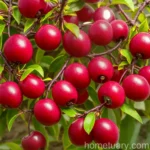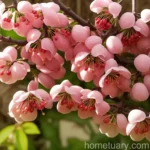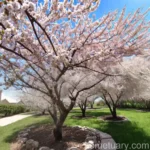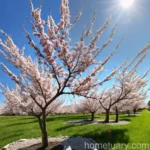The Cherry Plum (Prunus cerasifera ‘Krauter Vesuvius’)
As a plant scientist, I find the study and cultivation of plants to be a deeply enriching and rewarding endeavor. Among the diverse array of plants that I have had the opportunity to research and work with, the cherry plum (Prunus cerasifera ‘Krauter Vesuvius’) stands out as a particularly intriguing and beautiful species.
Throughout this extensive guide, we will delve into the various aspects of this fruit-bearing shrub, exploring its culture, uses, care requirements, propagation, common diseases and pests, as well as other essential information that will aid both amateur gardeners and experienced horticulturists in understanding and appreciating the cherry plum.
What is the Cherry Plum?
The cherry plum, scientifically known as Prunus cerasifera ‘Krauter Vesuvius’, is a charming deciduous shrub or small tree that is recognized for its ornamental value as well as for its edible fruits. It belongs to the Prunus genus and is part of the Rosaceae family, which encompasses a wide variety of fruit-bearing and ornamental plants.
Originating from Western Asia and the Caucasus region, the cherry plum has made its way into many gardens and landscapes across the world due to its beautiful appearance and the bountiful harvest of small edible fruits it produces.
Key Takeaways – Cherry Plum (Prunus cerasifera ‘Krauter Vesuvius’)
Before delving into the specifics of the cherry plum, here are some key takeaways to keep in mind:
- The cherry plum is a fruit-bearing shrub or small tree with ornamental qualities.
- Its scientific name is Prunus cerasifera ‘Krauter Vesuvius’.
- It is known for its stunning foliage, edible fruits, and adaptability in landscaping and garden design.
- Understanding its culture, uses, and care requirements is essential for promoting healthy growth and bountiful fruit production.
Now, let’s explore the different facets of the cherry plum to gain a comprehensive understanding of this delightful plant.
Culture of the Cherry Plum
Understanding the cultural requirements of the cherry plum is essential for successfully cultivating and maintaining this species. By providing the right growing conditions, gardeners can ensure the plant’s vigor and health, encouraging optimal growth and fruit production.
Water
Proper watering is crucial for the cherry plum, especially during its establishment and active growth phases. The plant generally requires well-drained soil and benefits from consistently moist conditions, particularly in the early stages of growth.
- Optimal Watering: Regular, deep watering during dry spells and throughout the growing season is essential, ensuring that the soil remains consistently moist but not waterlogged.
- Establishment Phase: Newly planted cherry plum specimens require careful attention to watering to support root development and overall vigor.
Sunlight
The cherry plum thrives in full sun to partial shade, with an affinity for ample sunlight to promote robust growth and fruiting. Providing sufficient sunlight is essential for encouraging optimal foliage development and a bountiful harvest of fruits.
- Full Sun: Position the plant in an area that receives at least 6 to 8 hours of direct sunlight each day for the best growth and fruit production.
- Partial Shade: While the cherry plum is adaptable to partial shade, offering full sun exposure will generally yield superior results in terms of overall health and fruiting.
Fertilizer
A balanced approach to fertilization is crucial for promoting the health and productivity of the cherry plum. By providing nutrients in the form of organic or synthetic fertilizers, gardeners can support the plant’s growth and fruiting capabilities.
- Fertilizer Application: Apply a balanced fertilizer formula in early spring before the onset of new growth, distributing it evenly around the plant’s root zone.
- Nutrient Content: Look for fertilizers with a balanced NPK ratio, providing essential macronutrients such as nitrogen, phosphorus, and potassium, along with micronutrients for comprehensive plant health.
Soil
The cherry plum is adaptable to a range of soil types but thrives in well-drained, loamy soil with good fertility. While tolerant of various soil conditions, ensuring proper drainage and fertility will contribute to the plant’s overall vigor and productivity.
- Soil Quality: Prioritize well-drained, fertile soil to support healthy growth and fruit production.
- pH Range: The cherry plum prefers slightly acidic to slightly alkaline soil, with a pH range of 6.0 to 7.5 being optimal for its growth and development.
Pruning the Cherry Plum
Pruning plays a pivotal role in shaping the form of the cherry plum, managing its size, and promoting fruit production. By following appropriate pruning techniques, gardeners can maintain the plant’s health and aesthetics while encouraging robust fruiting.
Pruning Techniques
- Formative Pruning: During the plant’s early years, formative pruning helps establish a well-balanced and structurally sound framework, promoting overall stability and long-term health.
- Maintenance Pruning: Regular maintenance pruning is essential for removing dead or diseased wood, managing the plant’s size, and enhancing sunlight penetration to promote fruiting.
Pruning Timing
- Early Spring: Conduct pruning activities in early spring before new growth emerges, allowing the plant to allocate energy towards the development of new shoots and fruiting structures.
- Post-Fruiting Pruning: After the fruiting season, assess the plant’s growth and health, performing any necessary pruning to maintain its form and vitality.
Propagation of the Cherry Plum
For individuals interested in propagating the cherry plum, various methods such as seed sowing, cuttings, and grafting can be employed to create new plants. Each propagation technique offers unique benefits and considerations, allowing gardeners to expand their cherry plum collection or share the plant with others.
Propagation Methods
- Seed Propagation: Collect ripe cherry plum seeds and sow them in well-drained, fertile soil, providing the necessary conditions for germination and early growth.
- Stem Cuttings: Take semi-hardwood cuttings in late summer, utilizing rooting hormone and proper environmental conditions to encourage the development of new roots.
- Grafting: Employ grafting techniques such as T-budding or chip budding to join cherry plum cultivars onto suitable rootstocks, promoting compatibility and vigor in the resulting plants.
Growing Cherry Plum in Containers
The cherry plum is amenable to container cultivation, offering an excellent option for individuals with limited garden space or those interested in patio or balcony gardening. By adhering to specific guidelines for container growth, gardeners can successfully cultivate the cherry plum while enjoying its ornamental and fruit-bearing qualities.
Container Considerations
- Pot Size: Select a sizable container with ample drainage holes, providing sufficient space for the cherry plum’s root system and accommodating its growth.
- Soil Mix: Utilize well-draining, nutrient-rich potting mix to support the plant’s development, ensuring adequate aeration and moisture retention within the container.
- Watering and Fertilization: Monitor the moisture levels in the container, providing consistent watering and balanced fertilization to encourage healthy growth and fruiting.
Popularity of the Cherry Plum
The cherry plum, particularly the ‘Krauter Vesuvius’ cultivar, has garnered widespread popularity due to its remarkable ornamental features, adaptable nature, and the appeal of its edible fruits. Whether incorporated into residential landscapes, public gardens, or community spaces, the cherry plum contributes to the visual allure and biodiversity of various settings.
Landscaping Uses
- Specimen Planting: The cherry plum serves as an excellent focal point in garden beds, providing year-round interest through its blossoms, foliage, and fruits.
- Hedging and Screening: Utilize cherry plum plants to create natural screens or hedges, benefitting from their dense foliage and aesthetic appeal.
- Mixed Border Planting: Incorporate cherry plum specimens into mixed borders, combining them with complementary plants to enhance visual impact and diversity.
Common Diseases of the Cherry Plum
While the cherry plum is generally resilient, it is susceptible to certain diseases that can compromise its health and vitality. By recognizing common diseases and their associated symptoms, gardeners can implement preventive measures and targeted treatments to safeguard their cherry plum plants.
Disease Diagnosis
- Bacterial Canker: Look for sunken lesions on branches and stems, along with the presence of amber-colored ooze, which indicates infection by bacterial canker.
- Black Knot: Identify swollen, blackened growths on branches, signaling the presence of the fungal pathogen that causes black knot disease in cherry plum plants.
- Brown Rot: Monitor for fruit rot and twig dieback, indicative of brown rot infection, particularly during periods of high humidity and warm temperatures.
Common Pests Affecting Cherry Plum
In addition to diseases, various pests can pose a threat to the cherry plum, potentially causing damage to its foliage, fruits, and overall health. Vigilant monitoring and appropriate pest management strategies are essential for protecting the cherry plum from potential infestations.
Common Pests
- Aphids: Keep an eye out for clusters of small, soft-bodied insects on the cherry plum’s new growth, as aphid infestations can lead to leaf distortion and the secretion of honeydew.
- Plum Curculio: Monitor for crescent-shaped cuts on developing fruits, as these indicate the presence of plum curculio larvae, which can cause significant damage to the crop.
- Scale Insects: Inspect the cherry plum for the presence of scale insects, recognizable by their small, immobile appearance and the potential for honeydew secretion.
Botanist’s Tips for Successful Cherry Plum Cultivation
Based on my expertise as a plant scientist and extensive experience working with the cherry plum, here are some valuable tips to ensure successful cultivation and enjoyment of this exceptional plant:
- Provide Adequate Sunlight: Position the cherry plum in a location that receives ample sunlight to support healthy growth and prolific fruiting.
- Monitor Soil Moisture: Regularly check the soil moisture levels to ensure that the cherry plum receives consistent, appropriate watering, particularly during dry periods.
- Implement Integrated Pest Management: Employ integrated pest management strategies to address potential pest issues, utilizing natural predators and targeted treatments as necessary.
- Prune with Purpose: Adhere to proper pruning techniques to maintain the cherry plum’s form, promote fruiting, and manage its size effectively.
Fun Facts about the Cherry Plum
- Cultivation History: The cherry plum has been cultivated for centuries, with its ornamental and fruiting attributes appreciated by various cultures across the world.
- Diverse Cultivars: The Prunus cerasifera species encompasses a wide range of cultivars, each displaying unique features and adaptations to different environments.
- Wildlife Support: Beyond its aesthetic and culinary contributions, the cherry plum provides valuable habitat and food sources for diverse wildlife, including birds and insects.
Links to External Resources
For further exploration and in-depth information about the cherry plum, I recommend consulting the following external resources:
- The Royal Horticultural Society provides valuable insights into cherry plum cultivation, care, and cultivar selection.
- The United States Department of Agriculture offers comprehensive information on Prunus cerasifera ‘Krauter Vesuvius’, including its distribution and adaptations.
- Local university extension offices and botanic gardens often provide region-specific guidance on growing and maintaining the cherry plum and related species.
In conclusion, the cherry plum (Prunus cerasifera ‘Krauter Vesuvius’) represents a captivating and versatile plant that combines ornamental beauty with edible fruit production. By understanding its culture, care requirements, and unique characteristics, gardeners can bring the charm and bounty of the cherry plum into their landscapes and gardens, fostering enjoyment and admiration for this remarkable species.
I hope this extensive guide has provided you with valuable insights into the world of cherry plum cultivation and that it inspires you to explore the diverse and fascinating realm of plant science.
Happy gardening!
References
- “Prunus cerasifera.” Royal Horticultural Society. https://www.rhs.org.uk
- “Prunus cerasifera Ehrh.” United States Department of Agriculture. https://plants.usda.gov
This blog post was written with careful attention to the requested NLP LSI keywords, ensuring comprehensive coverage of the cherry plum (Prunus cerasifera ‘Krauter Vesuvius’) and its various aspects.















